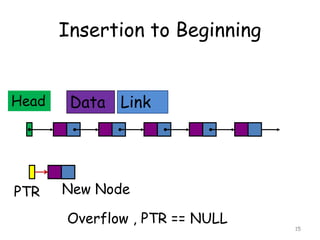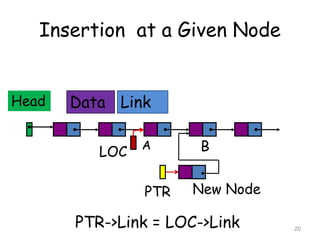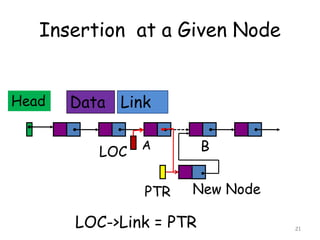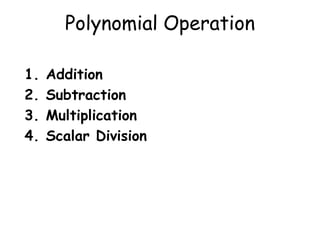4.linked list(contd.)
- 1. Data Structure & Algorithm CS 102 Ashok K Turuk
- 2. List Traversal Head Data Link 2
- 4. = Head Data Link PTR = PTR - > Link 4
- 5. List Traversal Let Head be a pointer to a linked list in memory. Write an algorithm to print the contents of each node of the list 5
- 6. List Traversal Algorithm 1. set PTR = Head 2. Repeat step 3 and 4 while PTR NULL 3. Print PTR->DATA 4. Set PTR = PTR -> LINK 5. Stop 6
- 7. Search for an ITEM • Let Head be a pointer to a linked list in memory. Write an algorithm that finds the location LOC of the node where ITEM first appears in the list, or sets LOC = NULL if search is unsuccessful. 7
- 8. Search for an ITEM Algorithm 1. Set PTR = Head 2. Repeat step 3 while PTR NULL 3. if ITEM == PTR -> DATA, then Set LOC = PTR, and Exit else Set PTR = PTR -> LINK 4. Set LOC = NULL /*search unsuccessful */ 5. Stop 8
- 9. Search for an ITEM Algorithm [Sorted ] 1. Set PTR = Head 2. Repeat step 3 while PTR NULL 3. if ITEM < PTR -> DATA, then Set PTR = PTR->LINK, else if ITEM == PTR->DATA, then Set LOC = PTR, and Exit else Set LOC = NULL, and Exit 4. Set LOC = NULL /*search unsuccessful */ 5. Stop 9
- 10. Insertion to a Linked List Head Data Link 10
- 11. Insertion to Beginning Head Data Link New NodePTR 11
- 12. Insertion to Beginning Head Data Link New NodePTR PTR->Link = Head 12
- 13. Insertion to Beginning Head Data Link New NodePTR PTR->Link = Head , Head = PTR 13
- 14. Overflow and Underflow • Overflow : A new Data to be inserted into a data structure but there is no available space. • Underflow: A situation where one wants to delete data from a data structure that is empty. 14
- 15. Insertion to Beginning Head Data Link New NodePTR Overflow , PTR == NULL 15
- 16. Insertion at the Beginning Let Head be a pointer to a linked list in memory. Write an algorithm to insert node PTR at the beginning of the List. 16
- 17. Insertion at the Beginning Algorithm 1. If PTR == NULL , then Write Overflow and Exit 2. Set PTR -> DATA = ITEM 3. Set PTR -> LINK = Head -> LINK 4. Set Head = PTR 5. Exit 17
- 18. Insertion After a Given Node Let Head be a pointer to a linked list in memory. Write an algorithm to insert ITEM so that ITEM follows the node with location LOC or insert ITEM as the first node when LOC == NULL 18
- 19. Insertion at a Given Node Head Data Link New NodePTR A BA LOC 19
- 20. Insertion at a Given Node Head Data Link New NodePTR BA LOC PTR->Link = LOC->Link 20
- 21. Insertion at a Given Node Head Data Link New NodePTR BA LOC LOC->Link = PTR 21
- 22. Insertion After a Given Node Algorithm 1. If PTR == NULL , then Write Overflow and Exit 2. Set PTR -> DATA = ITEM 3. If LOC == NULL Set PTR -> LINK = Head Set Head = PTR Else Set PTR->Link = LOC->Link Set LOC->Link = PTR 4. Exit 22
- 23. Insertion into a Sorted Linked List Head Data Link 1000 2000 3000 4000 5000 3500 3000 < 3500 < 4000 23
- 24. Insertion into a Sorted Linked List 1000 2000 3000 4000 5000 3000 < 3500 < 4000 BA To Insert Between Node A and B We have to Remember the Pointer to Node A which is the predecessor Node of B 24
- 25. Insertion into a Sorted Linked List Steps to Find the LOC of Insertion 1. If Head == NULL, then Set LOC = NULL and Return 2. If ITEM < Head ->Data , then Set LOC = NULL and Return 3. Set SAVE = Head and PTR = Head -> Link 4. Repeat Steps 5 and 6 while PTR NULL 5. If ITEM < PTR -> Data then LOC = SAVE and Return 6. Set SAVE = PTR and PTR = PTR->Link 7. Set LOC = SAVE 8. Return 25
- 28. Delete the Node Following a Given Node • Write an Algorithm that deletes the Node N with location LOC. LOCP is the location of the node which precedes N or when N is the first node LOCP = NULL 28
- 29. Delete the Node Following a Given Node • Algorithm: Delete(Head, LOC, LOCP) 1 If LOCP = NULL then Set Head = Head ->Link. [Deletes the 1st Node] Else Set LOCP->Link = LOC->Link [Deletes Node N] 2. Exit 29
- 30. Delete an Item Let Head be a pointer to a linked list in memory that contains integer data. Write an algorithm to delete node which contains ITEM. 30
- 31. Delete an Item 1000 2000 3000 4000 5000 4000 BA To delete a Node [Node B] We have to Remember the Pointer to its predecessor [Node A] 31
- 32. Deletion of an ITEM Algorithm 1. Set PTR=Head and TEMP = Head 2. Repeat step 3 while PTR NULL 3. If PTR->DATA == ITEM, then Set TEMP->LINK = PTR -> LINK, exit else TEMP = PTR PTR = PTR -> LINK 4. Stop 32
- 33. Deletion of an ITEM Algorithm 1. If Head == NULL , then Write ITEM is not in the List, Exit 2. If Head ->Data == Item Head = Head -> Link 3. Set PTR=Head and TEMP = Head 33
- 34. Deletion of an ITEM Algorithm 4. Repeat step 4 while PTR NULL If PTR->DATA == ITEM, then Set TEMP->LINK = PTR -> LINK, exit else TEMP = PTR PTR = PTR -> LINK 5. Stop 34
- 35. Header Linked Lists • A header linked list is a linked list which always contains a special node called header node • Grounded Header List: A header list where the last node contains the NULL pointer. Header Node 35
- 36. Header Linked Lists • Circular Header List: A header list where the last node points back to the header node. Header Node 36
- 37. Header Linked Lists • Pointer Head always points to the header node. • Head->Link == NULL indicates that a grounded header list is empty • Head->Link == Head indicates that a circular header list is empty 37
- 38. Header Linked Lists • The first node in a header list is the node following the header node • Circular Header list are frequently used instead of ordinary linked list – Null pointer are not used, hence all pointer contain valid addresses – Every node has a predecessor, so the first node may not require a special case. 38
- 39. Traversing a Circular Header List • Let Head be a circular header list in memory. Write an algorithm to print Data in each node in the list. 39
- 40. Traversing a Circular Header List Algorithm 1. Set PTR = Head->Link; 2. Repeat Steps 3 and 4 while PTR Head 3. Print PTR->Data 4. Set PTR = PTR ->Link 5. Exit 40
- 41. Locating an ITEM • Let Head be a circular header list in memory. Write an algorithm to find the location LOC of the first node in Head which contains ITEM or return LOC = NULL when the item is not present. 41
- 42. Locating an ITEM Algorithm 1. Set PTR = Head->Link 2. Repeat while PTR ->Data ITEM and PTR Head Set PTR = PTR ->Link 3. If PTR->Data == ITEM then Set LOC = PTR else Set LOC = NULL 4. Exit 42
- 43. Other variation of Linked List • A linked list whose last node points back to the first node instead of containing a NULL pointer called a circular list 43
- 44. Other variation of Linked List • A linked list which contains both a special header node at the beginning of the list and a special trailer node at the end of list 44 Header Node Trailer Node
- 45. Applications of Linked Lists 1. Polynomial Representation and operation on Polynomials Ex: 10 X 6 +20 X 3 + 55 2. Sparse Matrix Representation 0 0 11 22 0 0 0 0 66
- 46. 021 021 ...)( ee m e m xaxaxaxA mm Representation of Node Polynomials coef expon link
- 47. 3 14 2 8 1 0 a 8 14 -3 10 10 6 b 123 814 xxa 61014 1038 xxxb null null Example
- 48. Polynomial Operation 1. Addition 2. Subtraction 3. Multiplication 4. Scalar Division
- 49. 3 14 2 8 1 0 a -3 108 14 10 6 b 11 14 d a->expon == b->expon a b d a->expon < b->expon -3 10 Polynomial Addition 3 14 2 8 1 0 -3 108 14 10 6 11 14
- 50. 3 14 2 8 1 0 a 8 14 -3 10 10 6 b 11 14 a->expon > b->expon -3 10 d 2 8 Polynomial Addition
- 51. 3 14 2 8 1 0 a 8 14 -3 10 10 6 b 11 14 a->expon > b->expon -3 10 d 2 8 Polynomial Addition (cont’d) 10 6 1 0
- 52. 3 14 2 8 1 0 a -3 108 14 10 6 b -5 14 d a->expon == b->expon a b d a->expon < b->expon 3 10 Polynomial Subtraction 3 14 2 8 1 0 -3 108 14 10 6 -5 14
- 53. 3 14 2 8 1 0 a 8 14 -3 10 10 6 b -5 14 a->expon > b->expon 3 10 d 2 8 Polynomial Subtraction (cont’d)
- 54. 3 14 2 8 1 0 a 8 14 -3 10 10 6 b -5 14 a->expon > b->expon 3 10 d 2 8 Polynomial Addition (cont’d) -10 6 1 0
- 55. Sparse Matrix A sparse matrix is a very large matrix that contains lot of zero’s. In order to save storage space, a sparse matrix stores only the nonzero elements.
- 56. Linked list representation Sparse Matrix m n -- i j val i j val Null 0830 0000 9072 0500 A 4 4 -- 0 2 5 3 2 8 Null
- 57. Linked list representation Sparse Matrix aij i j ROWLINK COLLINK
- 58. Linked list representation Sparse Matrix 0830 0000 9072 0500 A 0 1 2 3 2 5 0 2 1 7 3 9 1 3 2 8
- 59. Two-Way List • What we have discussed till now is a one-way list [ Only one way we can traversed the list] • Two-way List : Can be traversed in two direction – Forward : From beginning of the list to end – Backward: From end to beginning of the list 59
- 60. Two-Way List • A two-way list is a linear collection of data element called nodes where each node N is divided into three parts: – A information field INFO which contains the data of N – A pointer field FORW which contains the location of the next node in the list – A pointer field BACK which contains the location of the preceding node in the list 60
- 61. Two-Way List • List requires two pointer variables: – FIRST: which points to the first node in the list – LAST: which points to the last node in the list 61 INFO field BACK pointer FORW pointer
- 63. Two-Way List 63 Suppose LOCA and LOCB are the locations of nodes A and B respectively in a two-way list. The statement that node B follows node A is equivalent to the statement that node A precedes node B Pointer Property: LOCA->FORW = LOCB if and only if LOCB->BACK = LOCA
- 64. Two-Way List 64 FIRST LAST A B Forward Pointer Node A Backward Pointer Node A
- 65. Two-Way List 65 FIRST LAST A B LOCA LOCB LOCA->FORW = LOCB if and only if LOCB->BACK = LOCA
- 66. Operation in two-way list • Traversing • Searching • Deleting • Inserting 66
- 67. Deletion in Two-Way List 67 FIRST LAST A B LOCB DELETE NODE B C LOCB->BACK->FORW LOCB->FORW=
- 68. Deletion in Two-Way List 68 FIRST LAST A B LOCB DELETE NODE B C LOCB->FORW->BACK LOCB->BACK=
- 69. Insertion in Two-Way List 69 FIRST LAST A B LOCA INSERT NODE NEW C NEW LOCA->FORW->BACK = NEW NEW->FORW = LOCA->FORW LOCA->FORW = NEW NEW->BACK = LOCA
- 70. ? 70









![Search for an ITEM
Algorithm [Sorted ]
1. Set PTR = Head
2. Repeat step 3 while PTR NULL
3. if ITEM < PTR -> DATA, then
Set PTR = PTR->LINK,
else if ITEM == PTR->DATA, then
Set LOC = PTR, and Exit
else
Set LOC = NULL, and Exit
4. Set LOC = NULL /*search unsuccessful
*/
5. Stop
9](https://image.slidesharecdn.com/4-160527095608/85/4-linked-list-contd-9-320.jpg)



















![Delete the Node Following a
Given Node
• Algorithm: Delete(Head, LOC, LOCP)
1 If LOCP = NULL then
Set Head = Head ->Link. [Deletes the 1st
Node]
Else
Set LOCP->Link = LOC->Link [Deletes Node
N]
2. Exit
29](https://image.slidesharecdn.com/4-160527095608/85/4-linked-list-contd-29-320.jpg)

![Delete an Item
1000 2000 3000 4000 5000
4000
BA
To delete a Node [Node B] We have to
Remember the Pointer to its predecessor
[Node A]
31](https://image.slidesharecdn.com/4-160527095608/85/4-linked-list-contd-31-320.jpg)



























![Two-Way List
• What we have discussed till now is a
one-way list [ Only one way we can
traversed the list]
• Two-way List : Can be traversed in two
direction
– Forward : From beginning of the list to end
– Backward: From end to beginning of the list
59](https://image.slidesharecdn.com/4-160527095608/85/4-linked-list-contd-59-320.jpg)










